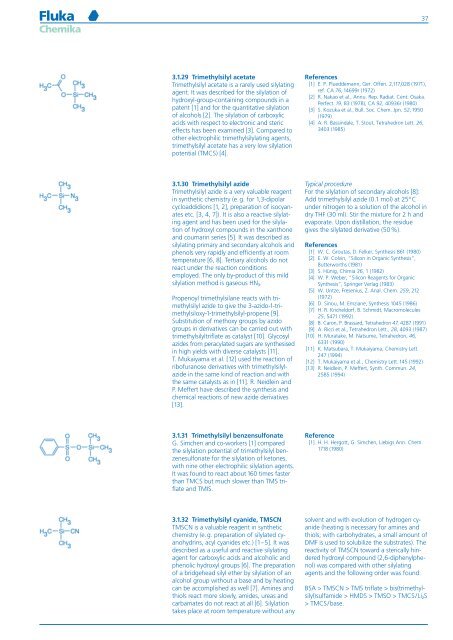Fluka - Sigma-Aldrich
Fluka - Sigma-Aldrich
Fluka - Sigma-Aldrich
You also want an ePaper? Increase the reach of your titles
YUMPU automatically turns print PDFs into web optimized ePapers that Google loves.
<strong>Fluka</strong><br />
Chemika<br />
3.1.29 Trimethylsilyl acetate<br />
Trimethylsilyl acetate is a rarely used silylating<br />
agent. It was described for the silylation of<br />
hydroxyl-group-containing compounds in a<br />
patent [1] and for the quantitative silylation<br />
of alcohols [2]. The silylation of carboxylic<br />
acids with respect to electronic and steric<br />
effects has been examined [3]. Compared to<br />
other electrophilic trimethylsilylating agents,<br />
trimethylsilyl acetate has a very low silylation<br />
potential (TMCS) [4].<br />
3.1.30 Trimethylsilyl azide<br />
Trimethylsilyl azide is a very valuable reagent<br />
in synthetic chemistry (e.g. for 1,3-dipolar<br />
cycloaddidions [1, 2], preparation of isocyanates<br />
etc. [3, 4, 7]). It is also a reactive silylating<br />
agent and has been used for the silylation<br />
of hydroxyl compounds in the xanthone<br />
and coumarin series [5]. It was described as<br />
silylating primary and secondary alcohols and<br />
phenols very rapidly and efficiently at room<br />
temperature [6, 8]. Tertiary alcohols do not<br />
react under the reaction conditions<br />
employed. The only by-product of this mild<br />
silylation method is gaseous HN 3.<br />
Propenoyl trimethylsilane reacts with trimethylsilyl<br />
azide to give the 3-azido-1-trimethylsiloxy-1-trimethylsilyl-propene<br />
[9].<br />
Substitution of methoxy groups by azido<br />
groups in derivatives can be carried out with<br />
trimethylsilyltriflate as catalyst [10]. Glycosyl<br />
azides from peracylated sugars are synthesised<br />
in high yields with diverse catalysts [11].<br />
T. Mukaiyama et al. [12] used the reaction of<br />
ribofuranose derivatives with trimethylsilylazide<br />
in the same kind of reaction and with<br />
the same catalysts as in [11]. R. Neidlein and<br />
P. Meffert have described the synthesis and<br />
chemical reactions of new azide derivatives<br />
[13].<br />
3.1.31 Trimethylsilyl benzensulfonate<br />
G. Simchen and co-workers [1] compared<br />
the silylation potential of trimethylsilyl benzenesulfonate<br />
for the silylation of ketones,<br />
with nine other electrophilic silylation agents.<br />
It was found to react about 160 times faster<br />
than TMCS but much slower than TMS triflate<br />
and TMIS.<br />
3.1.32 Trimethylsilyl cyanide, TMSCN<br />
TMSCN is a valuable reagent in synthetic<br />
chemistry (e.g. preparation of silylated cyanohydrins,<br />
acyl cyanides etc.) [1–5]. It was<br />
described as a useful and reactive silylating<br />
agent for carboxylic acids and alcoholic and<br />
phenolic hydroxyl groups [6]. The preparation<br />
of a bridgehead silyl ether by silylation of an<br />
alcohol group without a base and by heating<br />
can be accomplished as well [7]. Amines and<br />
thiols react more slowly, amides, ureas and<br />
carbamates do not react at all [6]. Silylation<br />
takes place at room temperature without any<br />
37<br />
References<br />
[1] E. P. Plueddemann, Ger. Offen. 2,117,028 (1971),<br />
ref. CA 76, 14699r (1972)<br />
[2] R. Nakao et al., Annu. Rep. Radiat. Cent. Osaka.<br />
Perfect. 19, 83 (1978), CA 92, 40936r (1980)<br />
[3] S. Kozuka et al., Bull. Soc. Chem. Jpn. 52, 1950<br />
(1979)<br />
[4] A. R. Bassindale, T. Stout, Tetrahedron Lett. 26,<br />
3403 (1985)<br />
Typical procedure<br />
For the silylation of secondary alcohols [8]:<br />
Add trimethylsilyl azide (0.1 mol) at 25°C<br />
under nitrogen to a solution of the alcohol in<br />
dry THF (30 ml). Stir the mixture for 2 h and<br />
evaporate. Upon distillation, the residue<br />
gives the silylated derivative (50%).<br />
References<br />
[1] W. C. Groutas, D. Felker, Synthesis 861 (1980)<br />
[2] E. W. Colvin, “Silicon in Organic Synthesis”,<br />
Butterworths (1981)<br />
[3] S. Hünig, Chimia 36, 1 (1982)<br />
[4] W. P. Weber, “Silicon Reagents for Organic<br />
Synthesis”, Springer Verlag (1983)<br />
[5] W. Untze, Fresenius, Z. Anal. Chem. 259, 212<br />
(1972)<br />
[6] D. Sinou, M. Emziane, Synthesis 1045 (1986)<br />
[7] H. R. Kricheldorf, B. Schmidt, Macromolecules<br />
25, 5471 (1992)<br />
[8] B. Caron, P. Brassard, Tetrahedron 47, 4287 (1991)<br />
[9] A. Ricci et al., Tetrahedron Lett., 28, 4093 (1987)<br />
[10] H. Muratake, M. Natsume, Tetrahedron, 46,<br />
6331 (1990)<br />
[11] K. Matsubara, T. Mukaiyama, Chemistry Lett.<br />
247 (1994)<br />
[12] T. Mukaiyama et al., Chemistry Lett. 145 (1992)<br />
[13] R. Neidlein, P. Meffert, Synth. Commun. 24,<br />
2585 (1994)<br />
Reference<br />
[1] H. H. Hergott, G. Simchen, Liebigs Ann. Chem.<br />
1718 (1980)<br />
solvent and with evolution of hydrogen cyanide<br />
(heating is necessary for amines and<br />
thiols; with carbohydrates, a small amount of<br />
DMF is used to solubilize the substrates). The<br />
reactivity of TMSCN toward a sterically hindered<br />
hydroxyl compound (2,6-diphenylphenol)<br />
was compared with other silylating<br />
agents and the following order was found:<br />
BSA > TMSCN > TMS triflate > bis(trimethylsilyl)sulfamide<br />
> HMDS > TMSO > TMCS/Li 2S<br />
> TMCS/base.

















